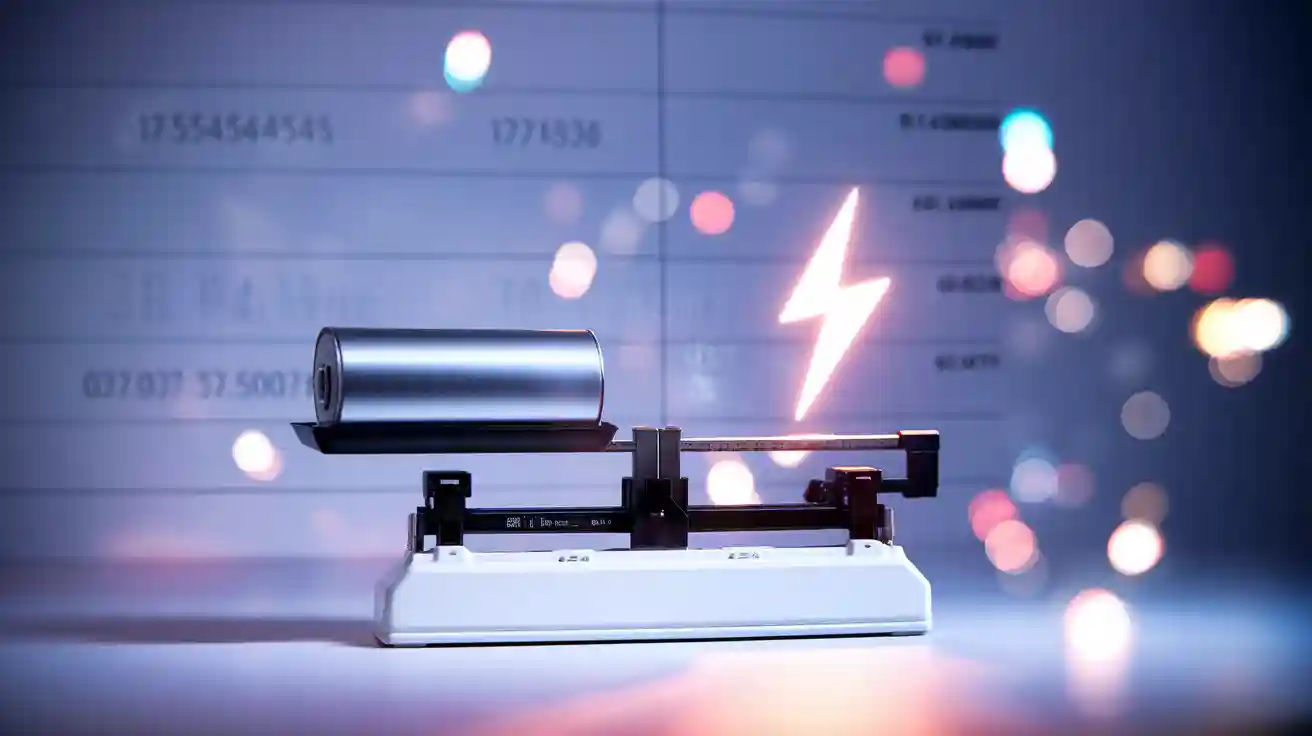
Imagine you want your electric vehicle to drive farther or your smartphone to last all day. You need to look closely at lithium-ion battery weight, energy density, and performance. These factors shape how portable, efficient, and powerful your devices feel. Recent trends show strong demand for lithium-ion batteries in cars, electronics, and even home energy storage.
- The global lithium-ion battery market is set to reach $221.7 billion by 2029.
- Major automakers and tech companies are scaling up production for better performance and lighter products.
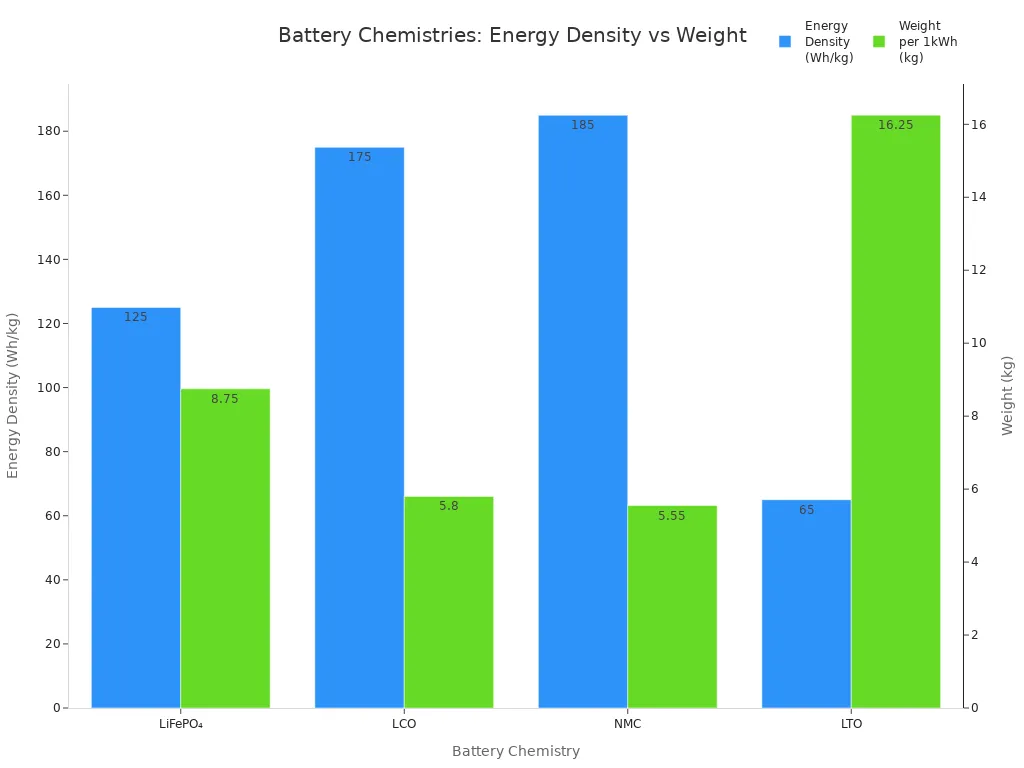
You notice that lightweight batteries with high energy density often deliver better performance in portable devices, while heavier batteries might last longer in stationary uses. When you choose a battery, think about how weight and performance will affect your daily experience.
Lithium-Ion Battery Weight Basics
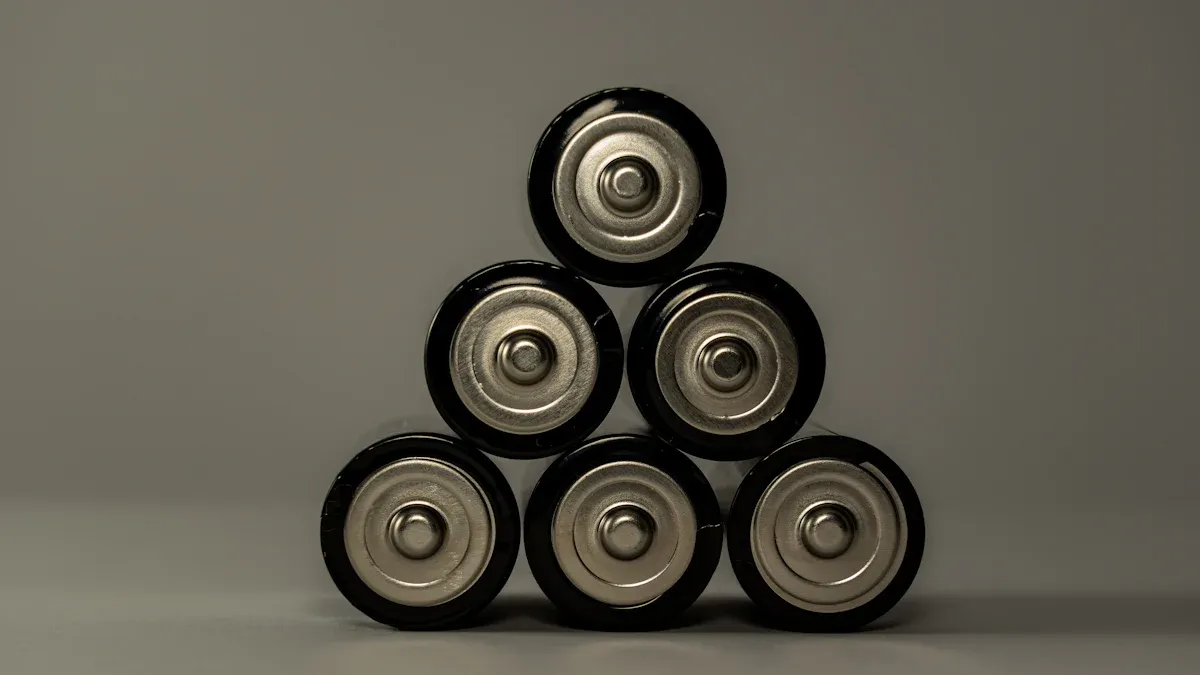
What Determines Lithium Battery Weight
When you look at lithium-ion battery weight, you see that several factors come into play. The most important ones are battery capacity, chemistry, application, and material composition. Each of these affects how much a battery weighs and how it performs in your devices.
- 容量: The higher the capacity, the more energy a battery can store. To get more capacity, you need more active materials inside the battery. This increase in materials leads to a higher lithium battery weight.
- 化学: Different types of lithium-ion batteries use different chemical formulas. For example, Lithium Iron Phosphate (LiFePO4) batteries are heavier but last longer and are safer. Nickel Manganese Cobalt (NMC) batteries are lighter and have higher energy density. This means you get more energy for less weight.
- 应用: The use of the battery changes its design. Electric vehicles need large, heavy batteries for long driving ranges. Portable electronics use smaller, lighter batteries to keep devices easy to carry.
- Material Composition: The materials used for the casing, electrolyte, and separators add to the lithium battery weight. Stronger casings protect the battery but also make it heavier.
Tip: You can estimate lithium-ion battery weight using a simple formula:
Battery Weight (kg) = Battery Capacity (Wh) / Energy Density (Wh/kg)
This formula helps you understand how capacity and energy density affect the final weight.
You should also know that the type and amount of electrolyte, as well as the density of the casing material, play a role. These details matter most when you need to balance performance and portability, like in electric vehicles or smartphones.
How Much Does a Lithium Battery Weigh
You might wonder, how much does a lithium battery weigh? The answer depends on the lithium battery size, chemistry, and application. Lithium-ion battery weight can range from just a few grams to several hundred kilograms.
下面是一些 typical examples to help you understand lithium battery weight across different formats:
| Battery Format | Dimensions (mm) | Typical Weight (g) |
|---|---|---|
| AA (alkaline) | ~14 x 50-70 | ~14-15 |
| 18650 | 18 x 65 | ~40-50 |
| Prismatic F3 | 5.6 x 16.5 x 22 | 8 |
| Prismatic F4 | 5.6 x 16.5 x 31.5 | 11 |
| Prismatic F5 | 5.6 x 16.5 x 35.5 | 12 |
| Prismatic F6 | 5.6 x 16.5 x 48 | 18 |
| Prismatic F8 | 5.6 x 16.5 x 66 | 25 |
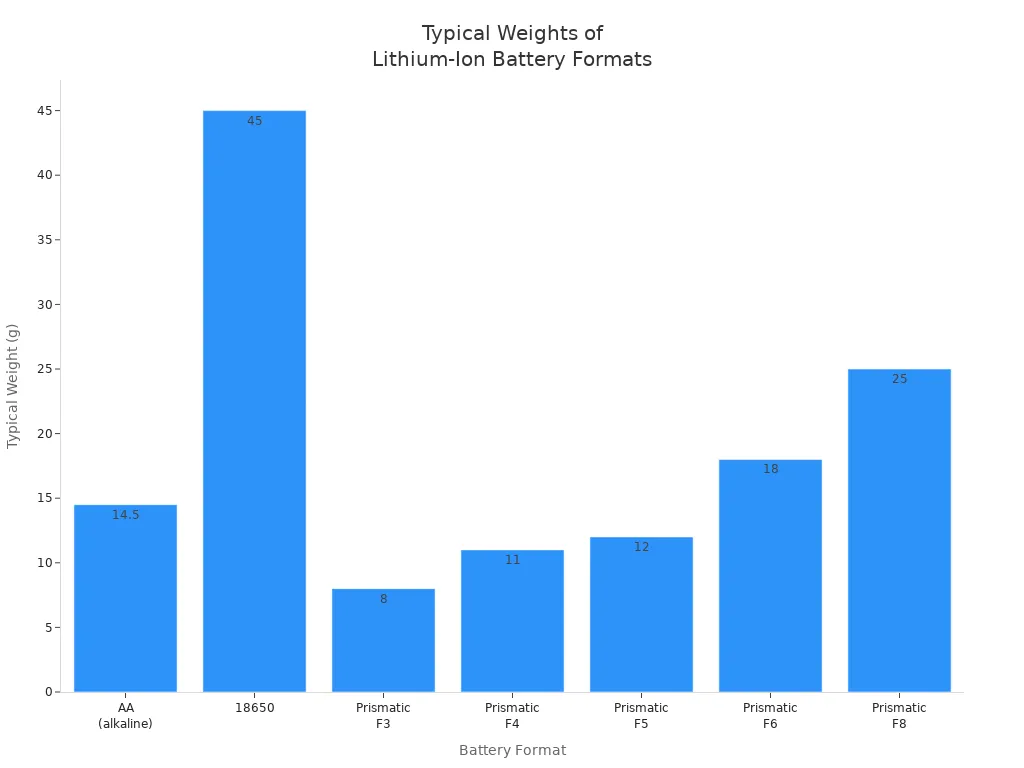
If you look at a standard AA lithium-ion battery, you find it weighs about 20 grams. A popular 18650 cell, often used in laptops and flashlights, weighs around 40 to 50 grams. Larger batteries, like a 12V 100Ah NCM battery, can weigh between 7 and 9 kilograms. A 24V 100Ah LiFePO4 battery weighs even more, usually between 20 and 22 kilograms.
For electric vehicles, lithium battery weight increases with capacity. A Tesla Model S 85 kWh battery weighs about 540 kilograms. The Nissan Leaf 40 kWh battery weighs around 303 kilograms. These numbers show how much does a lithium battery weigh when you need high capacity for long driving ranges.
You also see differences in lithium ion battery sizes and weights for home energy storage. A typical home battery pack can weigh anywhere from 20 to 100 kilograms, depending on the lithium battery size and capacity.
- Small portable batteries: 8–50 grams
- Medium batteries (power tools, e-bikes): 500 grams–3 kilograms
- Large batteries (EVs, home storage): 7–540 kilograms
When you choose a battery, always consider battery sizing for your needs. The right lithium battery weight ensures your device works well without being too heavy or bulky.
Note: The weight of a lithium-ion battery affects not only how easy it is to carry but also how well it performs in your application. Always check the lithium battery weight before making a choice.
Energy Density Explained
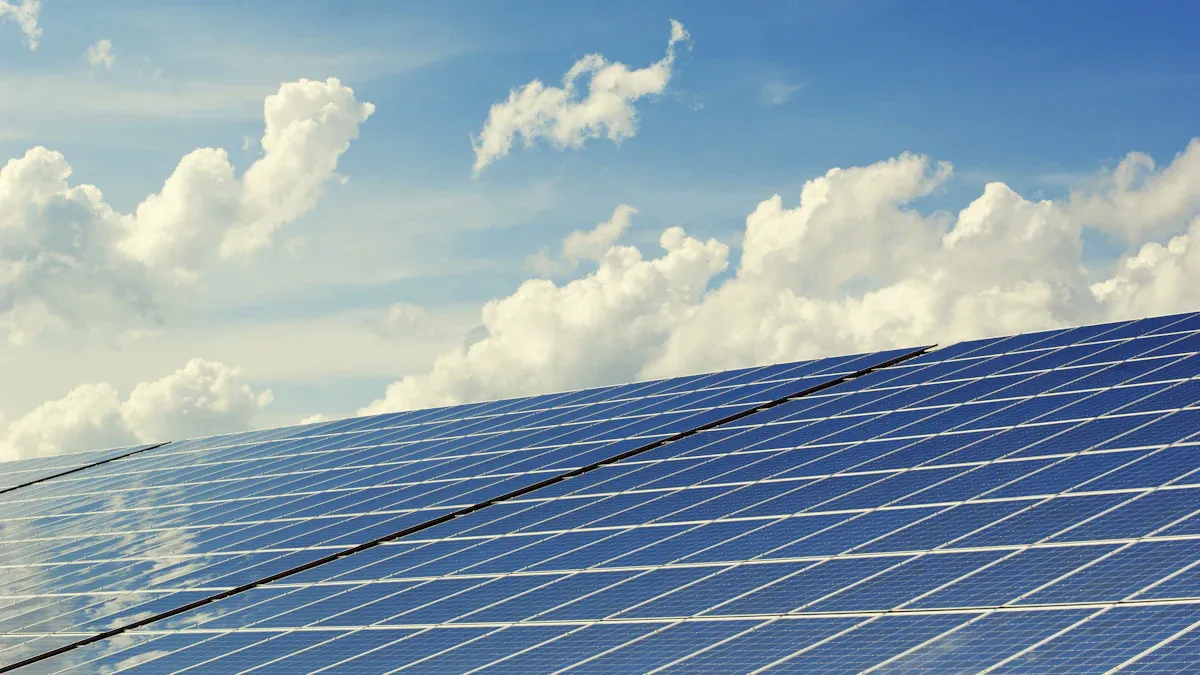
Gravimetric vs. Volumetric Energy Density
When you look at a lithium-ion battery, you often hear about 能量密度. This term tells you how much energy the battery can store compared to its size or weight. You can measure energy density in two main ways: gravimetric and volumetric.
- Gravimetric energy density measures how much energy a battery holds for each kilogram of weight. You see this value written as watt-hours per kilogram (Wh/kg). If you want a battery that is light but powerful, you should look for a high gravimetric energy density. This is important for things like drones, electric bikes, or even aerospace, where every kilogram matters.
- Volumetric energy density tells you how much energy fits into each liter of battery volume. You see this as watt-hours per liter (Wh/L). This matters most when you have limited space, such as in smartphones, tablets, or electric cars. A battery with high volumetric energy density lets you pack more power into a small area.
You can use these formulas to compare batteries:
- Gravimetric Energy Density = Battery Energy (Wh) / Weight (kg)
- Volumetric Energy Density = Battery Energy (Wh) / Volume (L)
Both types of density help you understand how efficient a lithium-ion battery is. If you want a battery for a device you carry, you care about the energy-to-weight ratio. If you need to fit a battery into a tight space, you focus on energy per volume.
Today, commercial lithium-ion batteries reach about 275 Wh/kg for gravimetric energy density and around 750 Wh/L for volumetric energy density. These numbers show how much energy you get for the weight and size of the battery. Most lithium-ion batteries you find in phones, laptops, and electric vehicles fall within these ranges.
Why Energy Density Matters
You might wonder why energy density is so important when choosing a lithium-ion battery. The answer is simple: energy density affects how long your device runs, how heavy it feels, and how much space the battery takes up.
- Energy density tells you how much energy a battery stores for its weight or size. This directly impacts how big or heavy your device will be.
- Lithium-ion batteries usually have energy densities between 150–250 Wh/kg and 300–700 Wh/L. These values make them perfect for mobile devices and electric vehicles.
- A battery with high energy density gives you longer use times and lighter devices. You can carry your phone all day or drive your electric car farther without stopping to recharge.
- The energy-to-weight ratio is key for things like drones or electric cars. A high ratio means you get more power without adding extra weight.
- Battery materials and design play a big role. Using materials like high-nickel cathodes or silicon anodes can boost energy density.
- Different lithium-ion battery types, such as lithium-polymer or LiFePO4, offer trade-offs. Some give you higher energy density, while others focus on safety or flexibility.
When you pick a battery, you need to match the energy density to your needs. For example, if you want a lightweight laptop, you look for a battery with high gravimetric energy density. If you need a battery for a small gadget, you care about volumetric energy density.
| 应用 | 重力能量密度(Wh/kg) | 体积能量密度(Wh/L) |
|---|---|---|
| 智能手机 | 200–250 | 400–600 |
| 电动汽车 | 150–275 | 400–750 |
| Home Storage | 100–200 | 200–400 |
Note: Higher energy density means you get more energy in a smaller, lighter battery. This leads to longer driving ranges for electric vehicles and longer use times for portable electronics.
You also benefit from faster charging and better performance. High energy density batteries can deliver quick bursts of power, which helps with things like fast acceleration in electric cars or smooth performance in your devices.
As battery technology improves, you will see even higher energy densities. This means future lithium-ion batteries will be lighter, smaller, and last longer. You will enjoy better efficiency and more powerful devices without extra weight.
Lithium-Ion Battery Capacity
Capacity and Weight Relationship
You may notice that when you choose a battery with higher capacity, the weight also goes up. This happens because a battery with more capacity stores more energy. To do this, the battery needs more active materials inside. As a result, the weight increases in direct proportion to the capacity.
The energy density of a battery, measured in watt-hours per kilogram (Wh/kg), helps you understand how much energy you get for each kilogram of weight. Most lithium-ion batteries have an energy density between 100 and 265 Wh/kg. If you want to estimate the weight of a battery, you can use this formula:
Battery Weight (kg) = Battery Capacity (Ah) × Nominal Voltage (V) / Energy Density (Wh/kg)
For example, a 2.5 Ah battery at 3.7 V with 200 Wh/kg energy density weighs about 46 grams. You see this pattern in real products. AA lithium-ion batteries weigh about 14.5 to 15 grams. Power banks with 10000mAh capacity weigh between 150 and 230 grams. Electric vehicle battery packs can weigh 6 to 8 kg for every kWh of capacity. Different chemistries, like Lithium Iron Phosphate (LFP) and Nickel Manganese Cobalt (NMC), also affect weight. LFP batteries usually weigh more for the same capacity because they have lower energy density.
Measuring Capacity
You measure battery capacity in ampere-hours (Ah) or milliampere-hours (mAh). This number tells you how much electric charge the battery can deliver over time. A higher capacity means the battery can power your device for a longer period before you need to recharge it.
Manufacturers often list battery capacity on the label. For small devices, you see capacity in mAh, such as 3000mAh for a smartphone battery. For larger batteries, like those in electric vehicles, you see capacity in Ah or even kilowatt-hours (kWh). You can also calculate the total energy stored by multiplying the capacity (Ah) by the battery’s nominal voltage (V). This gives you watt-hours (Wh), which is another way to compare batteries.
Tip: Always check both the capacity and the weight when you select a battery. This helps you find the best balance between how long your device runs and how heavy it feels.
Battery Chemistry and Design
Common Lithium-Ion Chemistries
You will find several types of lithium-ion chemistries in commercial batteries. Each chemistry has a unique balance of energy density, weight, safety, and cycle life. The most common types include LCO, LMO, LFP, NMC, NCA, and LTO. These chemistries power everything from smartphones to electric vehicles.
| 化学 | Composition | 典型应用 | 能量密度(Wh/kg) | Cycle Life (cycles) | Safety & Stability | 出院率 | Distinguishing Features |
|---|---|---|---|---|---|---|---|
| LCO (Lithium Cobalt Oxide) | Cobalt oxide cathode, graphite anode | Smartphones, cameras, laptops | ~200 | 500–1,000 | Lower safety, prone to overheating | 1C | High specific energy, fast charging, high cobalt content |
| LMO (Lithium Manganese Oxide) | Manganese oxide cathode, graphite anode | Power tools, e-bikes, medical equipment | ~150 | 300–700 | Higher thermal stability | 1C, up to 10C | High power output, limited capacity |
| LFP (Lithium Iron Phosphate) | Iron phosphate cathode, graphite anode | Industrial machines, EVs, logistics | ~177 | >4,000 | Very high safety and thermal stability | 1C/3C | Long cycle life, cobalt-free, flat discharge curve |
| NMC (Nickel Manganese Cobalt Oxide) | Nickel, manganese, cobalt cathode | Automotive, EVs | 150–220 | 1,000–2,000 | Balanced safety and energy density | 1C–3C | High energy density, widely used in EVs |
| NCA (Nickel Cobalt Aluminum Oxide) | Nickel, cobalt, aluminum cathode | Automotive sector | ~250 | ~1,000 | Slightly lower safety | 2C/3C | Very high energy density, often blended with NMC |
| LTO (Lithium Titanate) | Lithium titanate anode | Heavy-duty vehicles, AGVs | ~60–70 | 15,000–20,000 | Excellent safety | 4C/8C | Extremely long cycle life, low energy density |
You can see that LFP batteries stand out for their long cycle life and safety. NMC and NCA batteries offer high energy density and are lighter, making them popular in electric vehicles. LCO batteries provide high energy density but have safety concerns and shorter cycle life. LTO batteries last the longest but have low energy density and higher weight.
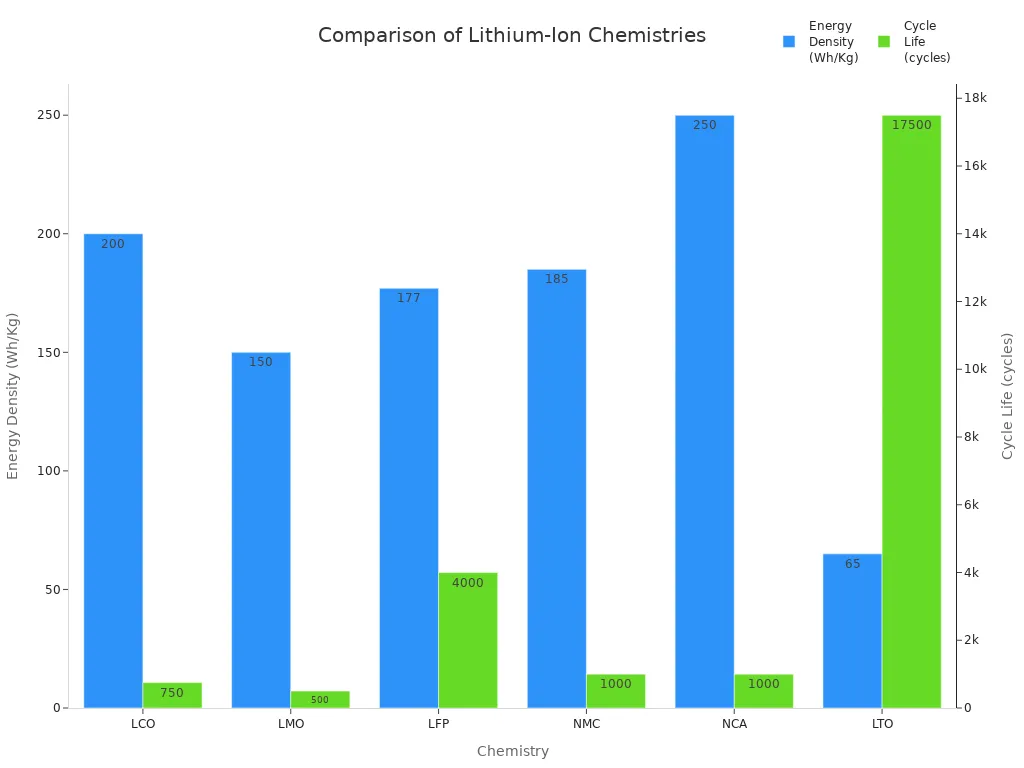
Impact on Weight and Energy Density
The chemistry you choose has a big impact on lithium battery weight and energy density. NMC batteries give you higher energy density, so you get more energy for less weight. LFP batteries have lower energy density, which means they are heavier for the same amount of energy. If you want a lightweight battery for a device or vehicle, NMC or NCA chemistries work best. LFP batteries are better if you need safety and a long cycle life.
| Parameter | LFP (Lithium Iron Phosphate) | NCM (Nickel Manganese Cobalt) |
|---|---|---|
| Weight Energy Density | 90-120 Wh/kg | 150-250 Wh/kg |
| Volume Energy Density | 300-350 Wh/L | 500-700 Wh/L |
| 电压 | 3.2 V | 3.7 V |
You will notice that NMC batteries are lighter and more compact for the same energy. This makes them ideal for electric vehicles and portable electronics. LFP batteries, while heavier, offer a long cycle life and better safety. If you need a battery that lasts many years, LFP is a strong choice.
Material composition also affects lithium battery weight and density. NMC batteries use nickel, manganese, and cobalt in different ratios. For example, NMC811 uses 80% nickel, 10% manganese, and 10% cobalt. LFP batteries do not use nickel or cobalt, which lowers cost and improves safety but reduces energy density. Graphite is the main material for the anode in all chemistries.
请注意: Material costs now make up a large part of battery prices. The choice of chemistry affects not only performance but also the cost and sustainability of your battery.
When you select a battery, think about how chemistry, weight, energy density, and cycle life fit your needs. If you want a lightweight battery with high energy density, NMC or NCA is best. If you need a battery with a long cycle life and safety, LFP is a better option.
Applications and Selection
电动汽车
You see electric vehicles everywhere today. The weight and energy density of lithium-ion batteries shape how far these vehicles can travel and how they perform. Heavier batteries add mass, which means the vehicle needs more energy to move. This reduces driving range and efficiency. Larger batteries can store more energy, but the extra weight brings diminishing returns and can affect acceleration and handling. Manufacturers use lightweight materials and optimize battery placement to improve stability and performance. They also focus on higher energy density chemistries, like NMC and NCA, to create lightweight battery packs for weight-sensitive applications. Unlike fuel tanks, lithium-ion batteries keep the same weight during use, so the vehicle’s dynamics stay constant.
| 电池化学 | 能量密度(Wh/kg) | Typical EV Range (miles) | 说明 |
|---|---|---|---|
| Nickel Cobalt Manganese (NCM) | 150-250 | 250-400 | Good energy density and lifespan |
| Nickel Cobalt Aluminum (NCA) | 200-260 | 300-400+ | High energy density for performance vehicles |
| 磷酸铁锂(LFP) | 90-160 | 150-300 | Safer, longer cycle life, lower energy density |
| Solid-State Batteries | 300-500 (future) | 400-600+ (future) | Higher density, still in development |
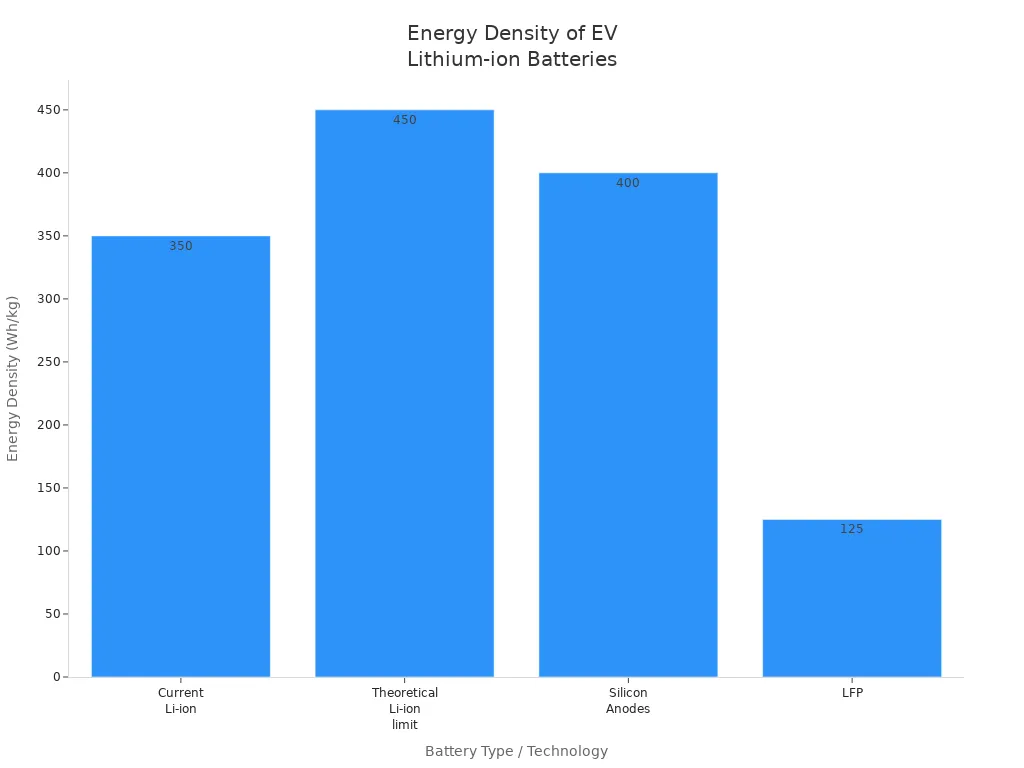
便携式电子产品
You use lightweight lithium batteries every day in smartphones, laptops, and tablets. These devices need lightweight batteries with high energy density to stay portable and slim. Battery weight affects how comfortable your device feels and how long you can use it. Most portable electronics use chemistries like LCO or NMC, which offer high density and keep weight low. For example, a 10000mAh power bank weighs about 150-230 grams. Lightweight lithium batteries allow you to carry your devices easily and enjoy longer use times. Drones and UAVs also rely on lightweight battery packs for better flight performance.
Renewable Energy Storage
Renewable energy storage systems, such as home solar batteries, need to balance energy density, weight, and safety. Higher energy density means you can store more energy in less space, which is important when space is limited. LFP batteries are common in renewable energy storage because they are safe and last a long time, even though they are heavier. NMC batteries offer higher density and are chosen when compactness matters. You often see modular, stackable battery units in these applications, making it easy to scale up storage as needed.
| 电池化学 | 能量密度(Wh/kg) | Weight Consideration | Safety & Longevity | 适用性 |
|---|---|---|---|---|
| NMC/NCA | 150–220 | Lighter, compact | Needs management | Space/weight-sensitive |
| 磷酸铁锂 | 90–120 | Heavier, larger | Very safe, durable | Stationary storage |
选择合适的电池
When you select a lithium-ion battery, start by listing your energy needs and how long you want your device or system to run. Calculate the total capacity you need using the formula:
Battery Capacity (Wh) = Average Load (W) × Backup Time (hrs)
Next, check the energy density and weight of available options. For weight-sensitive applications like electric vehicles, drones, and portable electronics, choose lightweight lithium batteries with high density. For stationary uses, such as renewable energy storage, you can prioritize safety and lifespan over weight. Always match the battery chemistry to your application. NMC and NCA work well for lightweight, high-performance needs. LFP is best for safe, long-lasting storage.
Tip: Lightweight batteries improve portability and user experience in weight-sensitive applications. Always balance energy density, weight, and capacity for the best performance.
You now know that lithium-ion battery weight, energy density, and capacity all shape how well your device or vehicle works. Each battery chemistry, like NCM or LFP, brings its own balance of cost, lifespan, and performance. When you choose a battery, match its features to your needs—think about safety, cycle life, and power, not just weight.
Tip: Always check the manufacturer, use a battery management system, and follow safe charging habits to get the best results. New materials and designs will keep making batteries lighter and more powerful, so stay updated for smarter choices.
常见问题
What is the difference between battery weight and energy density?
Battery weight tells you how heavy the battery is. Energy density shows how much energy the battery stores for its weight or size. You want high energy density for lighter, longer-lasting devices.
How do you choose the right lithium-ion battery for your device?
Start by checking your device’s power needs. Look at the battery’s capacity, weight, and energy density. Pick a battery that matches your usage and fits your device.
Tip: Always check the manufacturer’s recommendations.
Why do electric vehicles need lightweight batteries?
Lightweight batteries help electric vehicles go farther on a single charge. Less weight means better efficiency and faster acceleration. You get more range and better performance with a lighter battery pack.
Can a heavier battery last longer?
A heavier battery often has more capacity, so it can power your device longer. However, extra weight may not suit portable devices.
- For portable use, balance weight and capacity.
- For stationary use, higher weight can mean longer backup time.

